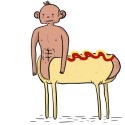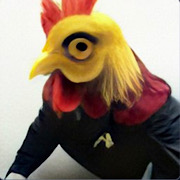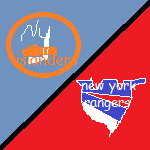|
I've got pants that are okay, but not great fit. I guess I'm trying to figure out how to make the adjustments without making a million pairs of okay pants.
|
|
|
|

|
| # ? Apr 16, 2024 15:38 |
|
Elissimpark posted:Would anyone be aware of a resource for building clothing patterns very specifically for tall men? Resources for building clothing patterns are the same regardless of size- learn how to draft patterns. Resources for modifying existing patterns are a little easier though. Here's a guide on grading which is how you enlarge/decrease a pattern by adding more/less at the seams. Good if the cut is right and you just need a little more/less fabric to get the right fit, but there's a point at which grading just fucks the pattern totally and you have to start with a new draft for the different size (see the woes of plus-sized clothes) The easiest thing as mentioned is to use another pair of pants as a template and in normal times I'd tell you to actively shop for the right pants at second-hand or cheap places with the intent of using them as a pattern. But since that's kind of not an option, you'll probably need to look at big and tall patterns and expect to have to cut them down a little. You can also checkout https://freesewing.org/ which is a site dedicated to providing patterns for your exact dimensions, and it also has a chat where you can talk about what you're doing and get advice. Downside is they have only have a few patterns especially for pants.
|
|
|
|
there wolf posted:Resources for building clothing patterns are the same regardless of size- learn how to draft patterns. Yeah, Aldrich was my first step to that end. there wolf posted:The easiest thing as mentioned is to use another pair of pants as a template and in normal times I'd tell you to actively shop for the right pants at second-hand or cheap places with the intent of using them as a pattern. I'm in Australia and nowhere really does tall sizes (at least, not at a premium) and op-shops just reflect that. Most of my pants in recent years I've had to order from the US just to get a decent inseam. there wolf posted:But since that's kind of not an option, you'll probably need to look at big and tall patterns and expect to have to cut them down a little. You can also checkout https://freesewing.org/ which is a site dedicated to providing patterns for your exact dimensions, and it also has a chat where you can talk about what you're doing and get advice. Downside is they have only have a few patterns especially for pants. That's a fantastic site! I never thought of looking for MtM patterns. I'm okay with only a couple of patterns - that's more than I have now.
|
|
|
|
ive had a bag of old clothes ive been adding to for a few years, always keeping it cause i told myself id deconstruct and remix it all. i FINALLY started deconstructing things this week. now i have >50 buttons, yards upon yards of fabric of all kinds, elastic i pulled from waistbands, pockets, zippers, etc. really excited to have some fun with this stuff. anybody have a favorite scrap project? i think im gonna start with some masks and maybe a small plush
|
|
|
|
Thatís awesome! I have a big olí bag of stuff Iíve told myself Iíll repurpose. Quilting cottons and muslins have gone to my ďmaskĒ pile, teeny tiny scraps are for stuffing plushes and I made a TON of T-shirt yarn to make a braided rug. Iíve seen braided scrap rugs made out of pretty much anything. Some people stitch them by hand and others stitch them by machine. Only advice I have so far is to sew it on a flat surface and go loose on the curves. Iím going to back mine with flannel because the shirts Iím using are pretty thin.
|
|
|
|
I do the same!! I need to go through it. Right now I've got a lot of t-shirts I want to make into scarves or face wraps. I also like to make headbands out of old clothes
|
|
|
|
|
verycute posted:ive had a bag of old clothes ive been adding to for a few years, always keeping it cause i told myself id deconstruct and remix it all. I use scraps of t-shirt fabric to make washable cosmetic pads! Just layer a few squares on top of each other and sew them together in a little stack. Bigger ones can work as coasters! (I have very basic skills, but I hate spending money and I hate generating trash)
|
|
|
|
Fleta Mcgurn posted:I use scraps of t-shirt fabric to make washable cosmetic pads! Just layer a few squares on top of each other and sew them together in a little stack. Bigger ones can work as coasters! yoooo this is such a good idea. i don't use cosmetic pads much but i could certainly use some coasters im the same way, my skills are...ok? and i kind of improvise a lot of my projects? but there is a particularly joy in making something i haven't worn in years wearable/useable again.
|
|
|
|
verycute posted:yoooo this is such a good idea. i don't use cosmetic pads much but i could certainly use some coasters I have one job I really hate because I basically have to sit there and listen to my boss and his girlfriend scream at each other for five hours every day, so I do little craft projects to keep my brain switched on while I wait out the daily tornado. Or I play Animal Crossing! Oooh, also you can use strips of t-shirt material as shoe/bootlaces.
|
|
|
|
I recently completed a project where I salvaged the material from a riding shirt I ruined in a bike crash and sewed it into a neck gaiter/face mask and holy drat, sewing that jersey material on a regular machine is a total drag. I have a walking foot on the advice of every sewing blog I've read on the subject and am using a zigzag stitch so when I pull the mask it won't pop the thread. Does anyone have any further advice for making a project look nice if you're using a standard machine instead of a serger or is it just something I should just keep practicing? Mostly I've done things made of heavier canvas and cordura, my last couple projects were bags for my bike. Here's my most recent one: 
|
|
|
|
im absolute garbage on a sewing machine with anything other than straight up cotton which is why i handsew so much 😅 that saddle bag looks dope tho
|
|
|
|
The_Hatt posted:I recently completed a project where I salvaged the material from a riding shirt I ruined in a bike crash and sewed it into a neck gaiter/face mask and holy drat, sewing that jersey material on a regular machine is a total drag. I have a walking foot on the advice of every sewing blog I've read on the subject and am using a zigzag stitch so when I pull the mask it won't pop the thread. Does anyone have any further advice for making a project look nice if you're using a standard machine instead of a serger or is it just something I should just keep practicing? Ball point needle and playing with your stitch length/width? Your machine might also have faux overlock stitch patterns that work on knits you could play with. You could also try a removable stabilizer if the stretch is really bad.
|
|
|
|
The_Hatt posted:I recently completed a project where I salvaged the material from a riding shirt I ruined in a bike crash and sewed it into a neck gaiter/face mask and holy drat, sewing that jersey material on a regular machine is a total drag. I have a walking foot on the advice of every sewing blog I've read on the subject and am using a zigzag stitch so when I pull the mask it won't pop the thread. Does anyone have any further advice for making a project look nice if you're using a standard machine instead of a serger or is it just something I should just keep practicing? Ooh, nice bike bag! I mostly sew lycra knits, on a mechanical normal sewing machine. I really only have been doing this a few months, but I went hard mode after making a ton of masks and getting tempted by pretty compression fabric. Here's what I've learned:
On the plus side, no real worries about the fabric unraveling so no need to finish every single drat seam!
|
|
|
|
A week or two ago I asked for getting started resources, checked out the good stuff you guys recommended and browsed my local textiles store with my daughters (my oldest was in love, she made a list of about 15 fabrics she wanted dresses and tank tops of lol). Think I'm nearly ready to dive in, now all I need is a machine. I browsed fb market and kijiji and I'm really taken with antique singers... how practical would it be to use these for clothes making? I imagine they'd be quite capable and overbuilt, but is there something about modern ones I'd particularly prefer for clothes making? Being a mechanical engineer I'm in love with these classic antique machines and looking on youtube the setup looks fairly similar. Just don't know if I'm missing something from modern ones. Anyone have experience with these? I'm looking at like 100+ year old ones.
|
|
|
|
I know people who use them. No zigzag I think just straight line. Hard to find bobbins for.
|
|
|
|
|
For garment sewing you only really need a straight stitch (which youíll get on any machine) and maybe a zig zag (for seam finishing). New machines have a billion fancy decorative stitches youíll never use. Home machines with a zig-zag arenít introduced until the 50s or so. Before then people used pinking shears or other methods of seam finishing (French seams, flat-felled seams, Hong Kong finish/rayon seam binding, or whip-stitching the seams by hand, etc). Thatís the only thing I can think of that youíll miss on older electric machines... Any old machine youíll get youíll need to have serviced. I wouldnít spend a ton of money unless you can get a guarantee that itís operating. Servicing by itself will run you $100+.
|
|
|
|
hot cocoa on the couch posted:A week or two ago I asked for getting started resources, checked out the good stuff you guys recommended and browsed my local textiles store with my daughters (my oldest was in love, she made a list of about 15 fabrics she wanted dresses and tank tops of lol). Think I'm nearly ready to dive in, now all I need is a machine. I browsed fb market and kijiji and I'm really taken with antique singers... how practical would it be to use these for clothes making? I imagine they'd be quite capable and overbuilt, but is there something about modern ones I'd particularly prefer for clothes making? Being a mechanical engineer I'm in love with these classic antique machines and looking on youtube the setup looks fairly similar. Just don't know if I'm missing something from modern ones. That would be me, vintage Signer king of the thread. I have two, a 201-2 and a featherweight, that I use for everything, but much more quilting than clothes. In my opinion the big things you might miss by not getting a modern machine are the zig-zag and other stretch stitches for sewing knits/stretchy stuff, and a removable arm for sewing cuffs, armholes, and the like. As Croc pointed out, people sewed all that was sewed for almost a century on iron Singers (and similar machines.) So it's really up to whether you think the materials and construction techniques of roughly 18-1950 will suit what you and your daughters want, or whether you'd be better off with a modern machine that can do a little more. As for 100 year-old machines, excluding treadle and handcranks, that's pretty much just the 27/127's, 28/128's. I don't really recommend them as starter machines. They aren't bad, but they're finicky. Sewing machine gearheads love them because the model run is a collection of big and small changes that lead up to what is the modern sewing machine. Very cool, and probably something a mechanical engineer would get a kick out of, but not for a first machine. I recommend starting with a 201 if you're still interested in vintage Singers. Not as pretty as the 27/127, but it was the next big leap in Singer machines that kind of synthesized everything they learned from the previous generation. They're smooth, fast, easy to maintain and find parts for. In general when buying second-hand machines, make sure it runs before you buy. Check that the chord and the foot-pedal are in good condition, and look underneath and inside for any obvious problems with the mechanics. If you are getting it from anyone other than a dealer/restorer who's cleaned and wrapped it up for you, anticipate getting it serviced before using.
|
|
|
|
Yeah I use an 80-year-old Singer (30-something?) as my main machine. But I bought it already-serviced from a local Singer dealer. I also have a serger. For zigzag, you can find a very chunky attachment that will do that. I've never tried one though. The other big thing it doesn't have is a stretch stitch. You can sort of get around this by stretching the fabric as you sew, but that's finicky and prone to making ruffles. A lot of modern sewing (tights, t shirts, tank tops, stretchy dresses, hoodies, etc) uses stretch fabric and absolutely requires stretch stitch.
|
|
|
|
Chiming in with scrap chat, I've been making mask loops out of T-shirt yarn. I don't do ear loops, i do one big loop that fits over the head/at the neck, with sliding knots tied at the end to secure it. My friends have said that they find my masks more comfortable and secure because of it... but they might also just be saying nice things.
|
|
|
|
Oh yeah, as a follow-up now that I'm not phoneposting at 2am, the machine I have is a Singer 15-91, a lot like this one: http://www.needlebar.org/main/15chart/index.html The serial number is a JA series, which was in use from 1924-1936. But the 15-91 model was manufactured from 1932 onwards, so my machine was made sometime between 1932 and 1936. It works really well. As you said, they were ridiculously overbuilt (at least compared to anything you can get today), and tend to just last. Here's some info on the zigzag attachments you can get: https://www.oldsewingear.com/blog/you-zig-ill-zag As a mechanical engineer you'd have some fun with them, I'd imagine. But yeah, while you could use zigzag for sewing stretch fabrics, you'd be a lot better off with a more modern machine that does a straight stretch stitch. You can also get pretty far using a serger for stretch fabrics.
|
|
|
|
stab stabby posted:Chiming in with scrap chat, I've been making mask loops out of T-shirt yarn. I don't do ear loops, i do one big loop that fits over the head/at the neck, with sliding knots tied at the end to secure it. My friends have said that they find my masks more comfortable and secure because of it... but they might also just be saying nice things. That's my go-to mask design as well, although mine is a sort of doubled loop.  Can you post a picture of your sliding knots? Sounds interesting.
|
|
|
|
HelloIAmYourHeart posted:That's my go-to mask design as well, although mine is a sort of doubled loop. I'm pretty proud of this one, hahaha:  (This one was using paracord that I didn't burn the ends of right). Basically you just tie a regular knot with one end a couple inches from the end of the other end. Take that tail part and tie a similar knot on the end that was already tied. This link shows it well: https://makeandfable.com/2020/01/simple-sliding-knot/ When you put it on, you just hold each knot and pull them away from each other until it fits onto your head. If you leave too much slack though, it won't fit well. What I really like about this is that if you leave a lot of material for the ends (but not toooo much), you can make the mask even more secure because the ... loop? formed by the space between the sliding knots can form sort of this shape, which keeps the crown loop much more snug 
|
|
|
|
Oh, that's really clever! I usually use my ponytail as an anchor point for the top strap.
|
|
|
|
My mom makes masks that have extra long ďearĒ loops that are meant to go around a ponytail. They are pretty comfy.
|
|
|
|
 My dad designed and 3D printed these things for pulling ear loops around the back of your head, which seemed a little over-engineered to me.
|
|
|
|
Sitting here in the break room at work and considering buying a yard of 100% linen to make my work masks because this cotton one is boiling me to death...but at least I have confirmation that the pattern is good for me. Wonky rear end nose wire too, because I was hand stitching it at 4 in the morning while watching an lp.
|
|
|
|
|
I have a hard time finding fitting clothes so I plan on adjusting things! Luckily I already have access to a sewing machine. My plan is to pull out all the old clothes I donít wear and use them as practice and after that buy things based on what I can easily hem and make slimmer. I have some universal needles and it looks like higher tension is good for thinner/looser fabric like t-shirts (e.g. 6-7 out of 9). Is that right? Also I vaguely recall avoiding sewing anything too thick like denim on this machine. Given a lot of jeans these days are thin/stretchy does this still apply? Similar for chinos/shorts/etc. Itís not on my immediate agenda but I donít want to risk causing a problem. Thanks, friends. If you guys have any other advice for the novice tailor I'm all ears.
|
|
|
|
Impromptu Flip posted:I have a hard time finding fitting clothes so I plan on adjusting things! Luckily I already have access to a sewing machine. My plan is to pull out all the old clothes I donít wear and use them as practice and after that buy things based on what I can easily hem and make slimmer. Tension settings is going to be particular to your machine and what kind of thread you're using; if higher tension seems to be working then go with it. Remember that you have two sources of tension, the needle thread AND the bobbin thread, and problems with one will show on the opposite side of the seam - so bad needle tension will show up on the bottom of the seam. Stitches will be too tight or outright break (needs looser tension) or you'll get a nasty rats nest of thread (need tighter tension.) In general for needles you want fine needles for fine fabric and thicker ones for thick stuff. Universal needles are good for most wovens, but for knits (what t-shirt material is) and anything else stretchy you'll want a ball-point/stretch needle. Similarly you need denim needles for denim material. As for thicker materials, if your needles are going dull super quickly, or not penetrating all the way through and making a stitch/only picking up the bobbin thread sometimes resulting in super long stitches on the bottom of the material, than the material is too thick. Most home machines can punch through denim, home dec fabrics, and even leather just fine with the appropriate needle. If yours can't, then you'll want to get a better machine down the road.
|
|
|
|
I just got a significantly nicer machine (from a $200 Brother I got 13 years ago to a Pfaff Quilt Ambition 630) and the increase in piercing ability is astonishing. I feel like I could sew through a sheet of plywood.
|
|
|
|
I've got a Viking Emerald and coming from very occasionally using my moms old Singer 401A, it's ridiculous how strong it is. Doesn't really have the same stitch quality, but it's been pretty great as an all-around machine. I just successfully adjusted the fingers on a few pairs of leather work gloves last week, as an example.
|
|
|
|
there wolf posted:advice Thanks, much appreciated. I'll play around with it and see where I end up!
|
|
|
|
Hypnolobster posted:I've got a Viking Emerald and coming from very occasionally using my moms old Singer 401A, it's ridiculous how strong it is. Doesn't really have the same stitch quality, but it's been pretty great as an all-around machine. I just successfully adjusted the fingers on a few pairs of leather work gloves last week, as an example. I use a singer 401A and I go through layers of leather and heavy canvas for my work clothes and welding apron all the time. Unless I'm misreading and your post? My Singer has never left me wanting for power
|
|
|
|
Rotten Cookies posted:I use a singer 401A and I go through layers of leather and heavy canvas for my work clothes and welding apron all the time. Unless I'm misreading and your post? My Singer has never left me wanting for power She might also be using awful, awful needles or missing a user-alignment step or something. My sewing history is doing things as a kid, occasional clothes-fixing over the in-between ~25 years and now getting my own machine this past year, so I haven't actually touched her Singer since really spending time sewing for real.
|
|
|
|
I very recently got into sewing so that I could make masks and now that I'm sick of masks I want to branch out a bit. I've decided I would like to make some winter cloaks able to handle the PNW. The design is pretty simple: full circles with arm slits and a mantle, and a hood. What fabrics would be ideal and where can I find them without breaking the bank?
|
|
|
|
How much do you want to spend? Do you need it to keep you waterproof, or just warm? Wool (woven wool) is pretty traditional, but likely quite pricey. Polyester fleece is cheap, warm, and comes in a huge range of colours. (It can even be printed -- check out the AliExpress thread for peoples' experiences ordering realistic-looking burrito blankets. You could potentially order a weird printed blanket from AE and turn it into a cloak.) You could also use something woven with a fleece lining. The big thing, though, is to make sure your sewing machine can handle the thick fabrics that coats and cloaks are usually made from. You might even be better off hand sewing if it's something simple and doesn't need hems.
|
|
|
|
Boiled wool might be a good place to start, too.
|
|
|
|
It doesn't rain very heavily, but day-long drizzles are pretty common. I'm not looking for completely waterproof because I know that would use fabrics I'm not interested in using, like nylon. Obviously, for a winter cloak I'm going to want something warm. Research has pointed me in the direction of melton? I think I'd be willing to pay maybe 20bux per yard, which I know does exclude some of the more quality websites, but I'm still a beginner and don't want to get fabric that's so nice I'm afraid to use it. I was thinking that I would line the hood and mantle but leave the cloak unlined to help with the weight, so having a fabric that can stay warm without a ton of extra layers would be ideal.
|
|
|
|
I finally finished my One Block Wonder quilt that I started in December. (note: that link includes a tool that lets you see what the blocks will look like before you make them, which is cheating yourself of half the fun.) Front  Back (with original fabric)  I sent it out for quilting, but I pieced and bound it myself. I'm really happy with how it came out.
|
|
|
|
CantDecideOnAName posted:It doesn't rain very heavily, but day-long drizzles are pretty common. I'm not looking for completely waterproof because I know that would use fabrics I'm not interested in using, like nylon. Obviously, for a winter cloak I'm going to want something warm. Research has pointed me in the direction of melton? Melton is good; it's pea coat material so that tells you how much warmth and water resistance it's going to provide. Really you need to be looking at classic British outerwear for inspiration, and there's two directions to go with that, one more expensive than the other. Have you ever worn a cloak before? They're great at keeping you dry and warm, but they suck indoors and are more trouble to get on and off than a regular coat. I don't want to deter you, but outwear is worth spending a little more on because of it's functionality, and how much use and love you'll have for this garment should factor into how much you spend. All about that cloak life? Look to traditional British outdoorsman's clothing- woolen tweed or herringbone over silk linings for maximum warmth and dryness. If you want to do that, then I highly recommend doing a mock version out of cheaper materials (synthetic fleece and nylon) to test your pattern and give you a little more confidence. Then go buy the good stuff and make something really nice that will last a long time. Want to see what cloaks are like first? Look to trench coats - gabardine or laminate cottons over a flannel or fleece lining. You might want to do this anyway if you don't anticipate very cold winters because it won't be quite as warm as the wool. I live in a place with relatively mild winters and like to wear t-shirts year round, so a wool pea coat lets me do that. If you love sweaters and don't anticipate a lot of days below freezing, you might be better off with the lighter cloak that's more about repelling moisture than keeping you super toasty.
|
|
|
|

|
| # ? Apr 16, 2024 15:38 |
|
HelloIAmYourHeart posted:I finally finished my One Block Wonder quilt that I started in December. (note: that link includes a tool that lets you see what the blocks will look like before you make them, which is cheating yourself of half the fun.) Nice spirals! And is the leafy stuff in the border all quilted?
|
|
|






















